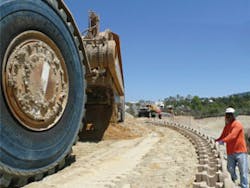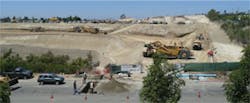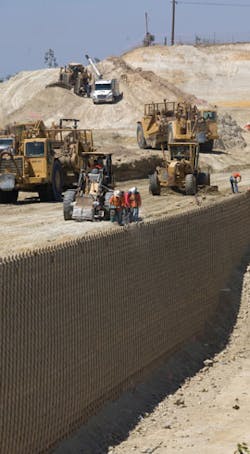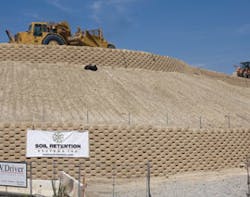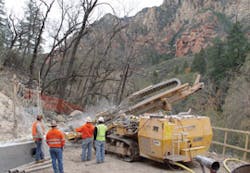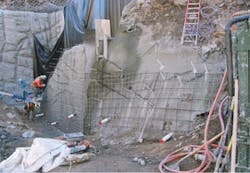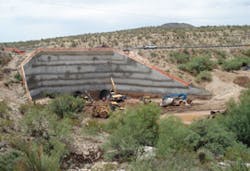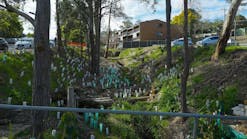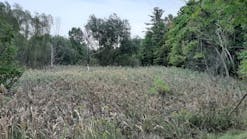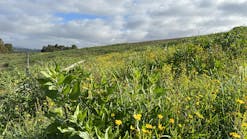In their natural habitat, hills and slopes can pretty much do as they please; they can allow vegetation or not, they can erode, and they can remain impassible.
However, hills and slopes that coexist with civilization have to conform: No landslides! No rockslides! Hills surrounded by prime real estate may also find themselves molded to humans’ needs. Fortunately for humans, today’s erosion control products allow us to make mountains into molehills fairly easily.
Turning Peaks Into Parking Lots
Most of the nation isn’t flat. Making a site buildable often requires a lot of earthmoving and securing. If the native site also includes wetlands that must be preserved, the challenge increases. Soil Retention Systems of Carlsbad, CA, recently faced such a task at the site of a Target store in California’s San Diego County.
Tons of soil moving was required to make this a buildable site.
The 20-acre site was “a hilly area,” says Mike Nelson, Target property development senior owners’ representative. “Our stores have a large footprint and require a flat parking area. Soil Retention Systems created an engineered-wall design for our store in Vista.”
Slopes were just part of the challenge. “One of the property’s sections does get wet, and it’s protected. The piece of property chosen is considered a wetland area, a natural drainage area, and we had to build walls right up to that. The natural lay of the land drops 60 feet to the bottom of the site, and we had to make it flat. One side, 25 feet of cut, had to be made level. This rise was 15 feet from the road-I’d say it was a relatively difficult site.”
Making the site usable requires building walls with a stepped effect. “We have double walls, 7 feet high, with a space between, and another 20-foot wall. We had to erect nine different walls, ranging in height from 2 to 15 feet, by the wetlands. The site also has two entrances, so walls had to be built to create the roads coming up to the store-two walls all the way up the road. That’s $1.5 million worth of walls! The walls are designed to handle earthquakes, and geogrid is installed behind each one. We actually needed two different types of designs, to resist earthquakes and erosion,” Nelson explains.
Soil retention wasn’t the only thing on the menu-a great deal of soil moving was required as well. “We had 250,000 cubic yards of cut and fill, and we had to get rid of 80 cubic yards of fill. If not for the walls, that figure would have been 300,000 cubic yards to remove! In addition, when preparing the site, we had to get easements from five different owners.”
Parts of the project are still in the works, Nelson notes. “I’ve discovered we have a couple areas with environment-sensitive plants; we may have to redesign the walls [in those areas]. I’ll make that decision [based] on what type of walls are used; maybe a zero-design, which goes straight up from the base, no recessed slant, will work.”
A good percentage of the walls used will be Soil Retention System’s plantable Verdura walls. “I handle the site work; this is a self-performed project. I have to decide what kind of wall I want, hire soil engineers, and so on,” says Nelson. “I like Verdura. It goes up quicker than some brands, and we can do heavy compaction with equipment right behind it-ease of installation. We like to plant it; most communities like that. Not only does it look better, but it adds some soil security with roots to hold the soil. If you have a wall that’s 20 feet high, planting hides some of that; plants make it look more natural.
“This is the second time I’ve used them. In the past, we’ve used a couple different kinds of retaining walls, but for the ease of installation, I like Verdura. I must have had 20 or 30 miles of them erected in Colorado. These go in much faster than many other brands,” he adds.
The work continues. “This is a 20-acre site, which will contain a 132,000-square-foot store. There are two more outspaces for other stores; we will sell the parcels. The site has a stormwater pond and an underground system that catches, holds back, and slows down “˜rushes’ of water, which is then releasable to the storm system.”
He adds that the only delays experienced at the site were from the required archaeological surveys: “We had to dig 15 to 20 feet down into the sandy clay soil, and some things were uncovered.”
When all the digging and building is done, the area must also be planted. “The plants to go in must be native to this area; most likely, we’ll use a native scrub brush.”
He says, “It’s taken $8 million for the whole contract for the site-widening streets, putting in pavement, landscaping fees, utilities, etc. The store is extra!”
Securing and Saving an Attractive Slope
Retaining walls hold back a slope, but in some instances, a hill can be aesthetically pleasing, so another form of slope stabilization might be used. For a Centex Homes subdivision, Pagnini’s Inc. of Antioch, CA, had the task of stabilizing a 2:1 slope that would end up as part of the “natural landscape.”
“We put approximately 20 rows of Earth Saver Rice Straw Wattles on that 400-foot slope,” says project
Walls of several different heights were constructed.
manager and estimator Dustin LaMantain. “The specs called for no more than 18 feet of space between rows; this project took about 2,500 wattles. The slope not only worked to prevent slides into the homes below, but it’s also going to be a permanent feature of the neighborhood.”
The slope required wattles on all sides: “Rainfall takes any natural direction in which the slope is built,” he says. “Wattles slow down the water’s velocity and filter any sediment that could get into the stormwater systems.”
LaMantain is confident about his choice. “Earth Saver wattles are top of the line. The company has a unique way of making them. They’re packed so tight [that] they hold to the specification of 9 inches. I don’t think some other brands of fiber rolls use enough straw. When you unload them, the bottom five wattles are actually only 4 inches thick from being compressed. They’re not true to the specifications that the state and water quality boards ask for.”
Earth Saver Rice Straw Wattles are made from recycled, naturally weed-free California rice straw, and are available with three types of netting: biodegradable, photodegradable, and burlap. They are available in three standard sizes: 9 inches by 25 feet, 12 inches by 10 feet, and 20 inches by 8 feet.
“Earth Saver wattles stay true to the weight. Yes, they used to be costly, but the way the market is out here, they’ve gotten competitive in their pricing, so there’s no reason why builders shouldn’t be product-specific.”
The wattles’ weight and density also help keep them in place. “Earth Saver wattles will stay in place. We measure distances, make sure the wattle is parallel to the slope, dig a trench or furrow, put the wattle in there, and stake it down. They need to be butted, or overlap-one behind the other-a foot or two, to be the most effective. Then we hydroseed the slopes.”
Any special challenges while the work was being done? “So much emphasis was placed on the safety of the crew,” LaMantain says. “Some times we did have to anchor our crews, due to the slope’s steepness, because gravity doesn’t cooperate. In addition, the sandy, rocky soil didn’t make it very easy to stand on the hill areas.”
Were any other options considered? “Silt fences were one option; the developer and I decided wattles were a better solution. A silt fence on a 2:1 slope wasn’t logical.”
Revegetation played its part in the stabilization. “Plants help filter out sediments; wildflower seeds were in the mix, as well as high- and low-growing grasses. The wattles are biodegradable; in two or three years, they’ll become part of the slope.”
The Centex project itself is still not complete. “They’ve had to do $2 million worth of grading alone. When the homes go in, of course, the cost of the development will go way up. Pagnini’s part of the project cost approximately $75,000, which includes the hydroseeding and fiber rolls. The project took us about one week, with a crew of seven guys. It was mostly manual labor-we could not use machines on that slope. You do what you can to get wattles up the hill, then do what you can to get them settled and tied down.”
Avoiding “Rock” and “Roll”
In some parts of the nation, more than just soil has to be contained. Soil erosion can cause the movement of large rocks, which not only can tumble down to the road and block traffic, but also can injure motorists.
During a six-month project, DBM Contractors Inc. of Federal Way, WA, repaired 350 feet of the roadsides along Arizona’s State Route 89A-an area prone to dangerous rockfalls. The route, which runs through the Oak Creek Canyon, connects Sedona and Flagstaff.
After centuries of erosion, Oak Creek Canyon’s steep slopes had developed natural draws; these channels allowed debris and rock an easy path toward the roadway. The solution, known as the Banjo Bill Rockfall Containment Project, included the installation of two 90-foot-long by 30-foot-high retaining walls, which were placed at the bottom of these channels, creating a basin to trap falling rocks.
In addition to its $7.5 million cost, the project faced other challenges. Because of the canyon’s very steep slopes, the Arizona Department of Transportation (ADOT) consultants had to design the state’s first anchored micropile wall system to facilitate construction on the steep slopes.
The project used 136 micropiles, placed at a 48-foot depth, which were installed every 16 inches, along with four rows of permanent tieback anchors. The micropiles were also supported laterally by anchored shotcrete facing. All of these supports were put in place to anchor the wall system. As heavy machinery was needed to construct all these supports, DBM built reinforced earth access benches at each wall location. As the anchors and shotcrete facing were installed, the team removed the temporary construction benches.
After the anchors and structural facing were completed, the wall was finished with architectural shotcrete facing that had been stained and carved. The resultant manmade “rockface” blends in with the local stone formations.
ecause of the area’s sensitive nature, all of the work was overseen by both the Forestry Department and ADOT. Foliage trimming and removal was strictly limited to the work areas. Oak Creek’s turbidity was regularly monitored, and the local spring, which is a residential water source, was also tested for any contamination, especially the cement grout used in the project. Even wildlife’s needs were taken into consideration; by scheduling construction between September 1, 2007, and March 30, 2008, crews avoided the endangered Mexican spotted owl’s breeding season.
As the project’s general contractor, DBM was responsible for the micropiles, the permanent tieback anchors,
the structural shotcrete, and all of the excavation work. Boulderscape of Capistrano Beach, CA, completed the architectural shotcrete fascia; NCS Consultants LLC of Tucson, AZ, and URS Corporation of Phoenix, AZ, provided engineering and design for ADOT; and additional subcontractors assisted with traffic control and surveying.
In the spring of 2008, DBM Contractors also completed a $6.2 million emergency road repair on Arizona’s US Route 70. Hired by the site’s co-owners, ADOT and the San Carlos Apache Indian Nation, DBM repaired a culvert and also built a retaining wall to prevent future incidents.
As the highway remained in use, DBM first had to develop a plan to divert traffic to a single lane around the 1,200-linear-foot work zone. When construction began, existing culverts had to be removed, and the area to be contained required a soil nail retaining wall. Ingress and egress access roads also had to be installed.
DBM’s project team fabricated and slip-lined three new 13-foot-diameter by 90-foot-long culverts through existing and deteriorated 15-foot-diameter culverts. In addition, 200 yards of annular grout was added to each culvert. DBM crews anchored the area with 415 permanent soil nails ranging from 15 to 43 feet long, installed 15,000 square feet of permanent shotcrete, and built wing wall ends of 30 to 65 feet. The site was quite a challenge; it contained very steep (1.5H:1V) slopes with loose rocks, boulders, and cavy soils. Any water needed had to be transported from a well 7 miles away.
With restricted access between both sides of the highway, most work
was performed from manlifts. The project was also complicated by the weather; crews toiled during the potential flash flood season, enduring record-breaking, 100-plus degree heat. Excavated earth was placed outside the Salt Creek Basin; DBM also scarified and replanted the 3-acre work area and restriped US Highway 70.
